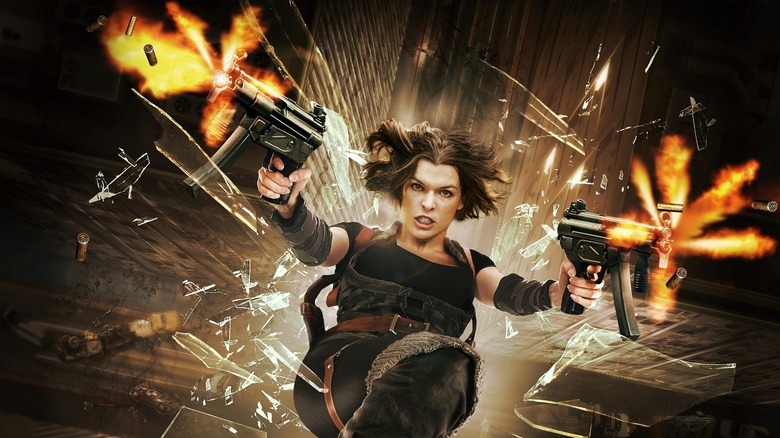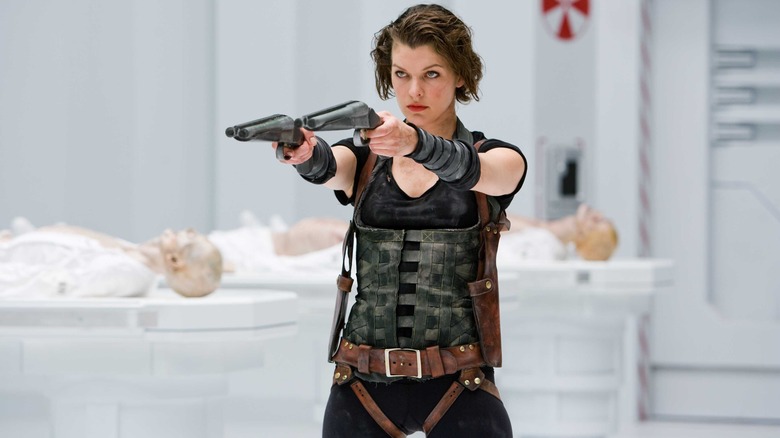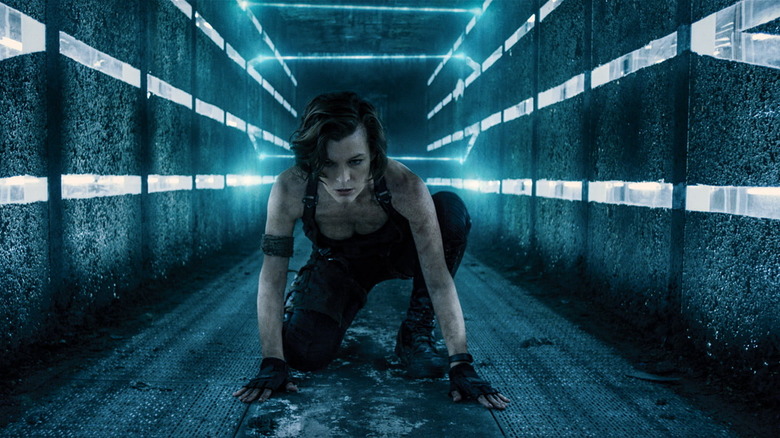Paul W.S. Anderson Hoped Avatar's Tech Could Revive The Resident Evil Franchise
The whole "Resident Evil" mishegoss began way back in 1996 with the release of the first "Resident Evil" video game on the Sony PlayStation. It was followed by many, many sequels — which is nothing to say of the mobile games, the seven live-action feature films, the four animated feature films, the two TV shows (one is still in production), the 21 novels, the nine separate comic book series, and the three stage plays. No Tony nominations to speak of, sadly. Oh yes, and the 15 pachinko machines. I'm also pretty sure I saw some "Resident Evil" branded ibuprofen the last time I was at the drug store.
The story of "Resident Evil" that required so much media to cover? It's about zombies.
Of course, the mythology of those zombies is far more complicated. In 2002, Paul W.S. Anderson's "Resident Evil" entered cinemas, introducing mainstream movie audiences to the evil Umbrella Corporation, a company that made everything from makeup to pharmaceuticals. One of their lab-created products was called the T-Virus, which turns people into zombies. Over the course of the first six films, the T-Virus would infect a lab, a small town, and eventually the entire world (as seen in the fourth film, 2010's "Resident Evil: Afterlife"), wiping out the population. The Umbrella Corporation also had a cloning facility for never-really-adequately-explained reasons, and would use it to clone the series' protagonist. In addition to zombies, the T-Virus could also occasionally turn people into superheroes ... or giant mutant monsters sometimes ... or something. It's not entirely clear.
Luckily, audiences had Milla Jovovich to lead the charge into the "Resident Evil" universe, and her capable ass-kicking talents kept zombies, mutants, and other creatures handily at bay for six movies. Anderson directed the first, fourth, fifth, and sixth entries in the series. That aforementioned fourth film was the first to be shot in 3-D, and Anderson had a clever way of going about filming it.
In 3-D!
"Resident Evil: Afterlife" takes place on a wasted Earth, overrun with the T-Virus. The very concept of making a fourth film after the previous two films had been called "Apocalypse" and "Extinction" seemed churlish, but Anderson's idea to shoot in high-quality 3-D might have been enough to convince financial backers to believe in an Afterlife. In an interview with Collider, prior to the release of Anderson's "Resident Evil: The Final Chapter," the director talked about how his new film was retrofitted for 3-D, and how that compared to the experience previously shooting "Afterlife."
It was thanks to the popularity of "Avatar" in 2009 that many studios began releasing their high-profile genre films in 3-D, sometimes shooting them with 3-D cameras, and sometimes shooting them in 2-D and converting them in post-production. The actual look of such conversions was infamously shoddy, adding little to the films in question. By 2017, the tech had advanced to a point that Anderson found acceptable. Previously, however, in order to achieve the right look, Anderson shot "Afterlife" using large, advanced 3-D cameras taken right off the set of "Avatar":
"I'm a very early adopter, I love technology. We literally took the cameras off the 'Avatar' set, so 'Resident Evil: Afterlife' was the first native 3-D movie to be released after 'Avatar.'"
Anderson learned a lot about the differences between shooting in 2-D and in 3-D when using those outsize "Avatar" cameras, and how the mere bulk of them made for dramatically different camera work. The size of 3-D cameras makes them difficult to work with:
"They're huge. 'Cause it's two cameras and an onboard computer and you have to put it on a crane most of the time ... [I]t's very restrictive to work like that."
When he finally came to "The Final Chapter," he had already learned how to set up a 3-D action shot and, drawing from his 2010 experience, knew how to make the film look more dynamic — while still doing a 2-D conversation. As he told Collider:
"I feel that finally it's gotten to that point that I could [do a 2-D conversion]. But what I did was I used my 3-D crew to shoot it. So while they were shooting 2-D, it was being framed with the knowledge of what makes a good 3-D shot."
The Final Chapter
If you've ever seen a picture of a studio-grade 3-D camera, like the kind used on the set of "Avatar," you can see how ungainly they are. They are indeed difficult to move. While having a heavy, locked-down camera is helpful for 3-D composition, it's not perfect for the kind of wild, swirling action Anderson wanted to film for "Final Chapter" — hence, his use of 2-D cameras. Anderson used Sony A7S cameras for the film. Anderson claims that even the 3-D conversion studio was impressed with his foresight to shoot a 2-D film with 3-D aesthetics in mind:
"I wanted to kind of get the camera places I never could've gotten it with a 3-D camera. You know it's up there, they're down there, they're in the face! They're really in the action this time around to make it much more immersive for the audience in a way that I could never have done with the 3-D cameras."
"Resident Evil: The Final Chapter," like the previous films in the series, was not welcomed with open arms by critics — it currently holds a mere 37% approval rating on Rotten Tomatoes — but it was, also like the previous films in the series, a pretty massive hit, grossing over $312 million worldwide on a $40 million budget. "Afterlife," meanwhile, was even less well-received in 2010, with only a 21% approval rating, but it ended up grossing over $300 million on a $60 million budget, making it the second highest-grossing in the series. In terms of visual clarity, one has to admit that "Final Chapter" and "Afterlife" are the most coherent of the series.
And those 3-D action shots are, admittedly, pretty cool.


